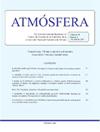Development of high-resolution annual climate surfaces for Turkey using ANUSPLIN and comparison with other methods
IF 1
4区 地球科学
Q4 METEOROLOGY & ATMOSPHERIC SCIENCES
引用次数: 2
Abstract
Many climate models have been developed because of the importance of climatic factors' effects on the physical and biological environment, e.g., rock weathering, species distribution, and growth patterns of plants. Accurate, reliable climate surfaces are necessary, especially for countries such as Turkey, which has a complex terrain and limited monitoring stations. The accuracy of these models mainly depends on the spatial modeling methods used. In this study, Australian National University spline (ANUSPLIN) model was used to develop climate surfaces and was compared with other methods such as inverse distance weighting, Co-Kriging, lapse rate, and multilinear regression. The results from the developed climate surfaces were validated using three methods: (1) diagnostic statistics from the surface fitting model, such as signal, mean, root mean square predictive error, root mean square error estimate, root mean square residual of the spline, and estimate of the standard deviation of the noise in the spline; (2) a comparison of error statistics between interpolated surfaces with and the withheld climate data from 81 stations; and (3) a comparison with other interpolation methods using model performance metrics, such as mean absolute error, mean error, root mean square error, and R2adj. The most accurate results were obtained by the ANUSPLIN model. It explained 95%, 88%, 92%, and 71% of the variance in annual mean, minimum and maximum temperature, and total precipitation, respectively. The mean absolute error of these models was 0.63 °C, 1.16 °C, 0.72 °C, and 54.82 mm. The generated climate surfaces, having a spatial resolution of 0.005º x 0.005º could contribute to the fields of forestry, agriculture, and hydrology.利用ANUSPLIN开发土耳其高分辨率年度气候面并与其他方法进行比较
由于气候因子对自然和生物环境的影响,如岩石风化、物种分布和植物生长模式的重要性,许多气候模型已经被开发出来。准确、可靠的气候表是必要的,特别是对土耳其这样地形复杂、监测站有限的国家来说。这些模型的准确性主要取决于所采用的空间建模方法。本研究采用澳大利亚国立大学样条(ANUSPLIN)模型发展气候表面,并比较了其他方法,如逆距离加权、Co-Kriging、递减率和多元线性回归。利用3种方法对发达气候面结果进行验证:(1)基于表面拟合模型的诊断统计量,包括信号、均值、均方根预测误差、均方根误差估计、样条的均方根残差和样条噪声的标准差估计;(2)比较了81个台站气候资料插值面与保留面误差统计;(3)与其他使用模型性能指标(如平均绝对误差、平均误差、均方根误差和R2adj)的插值方法进行比较。ANUSPLIN模型得到了最准确的结果。它分别解释了95%、88%、92%和71%的年平均、最低和最高气温和总降水量的方差。模型的平均绝对误差分别为0.63°C、1.16°C、0.72°C和54.82 mm。生成的气候面空间分辨率为0.005ºx 0.005º,可用于林业、农业和水文领域。
本文章由计算机程序翻译,如有差异,请以英文原文为准。
求助全文
约1分钟内获得全文
求助全文
来源期刊

Atmosfera
地学-气象与大气科学
CiteScore
2.20
自引率
0.00%
发文量
46
审稿时长
6 months
期刊介绍:
ATMÓSFERA seeks contributions on theoretical, basic, empirical and applied research in all the areas of atmospheric sciences, with emphasis on meteorology, climatology, aeronomy, physics, chemistry, and aerobiology. Interdisciplinary contributions are also accepted; especially those related with oceanography, hydrology, climate variability and change, ecology, forestry, glaciology, agriculture, environmental pollution, and other topics related to economy and society as they are affected by atmospheric hazards.
 求助内容:
求助内容: 应助结果提醒方式:
应助结果提醒方式:


